HA3032 - Auditing TPG Telecom: Risk, Procedure & Analysis
VerifiedAdded on 2023/06/04
|20
|4469
|147
Report
AI Summary
This report provides an in-depth analysis of the auditing process at TPG Telecom Limited, an Australian telecommunications company. It begins by outlining the importance of auditing in identifying financial statement issues and ensuring operational effectiveness. Key business risks, including development, regulatory, competition, and cyber-attack risks, are identified and their significance in the audit process is emphasized. The application of the audit risk model, including control risk, inherent risk, and detection risk, is discussed, along with analytical procedures using financial ratios like return on assets and equity. The report also details audit procedures using a substantive approach for material account balances and concludes with a proposed sampling plan for completing the audit. Desklib offers a wide range of solved assignments and past papers for students.

Auditing 1
Auditing
Auditing
Paraphrase This Document
Need a fresh take? Get an instant paraphrase of this document with our AI Paraphraser
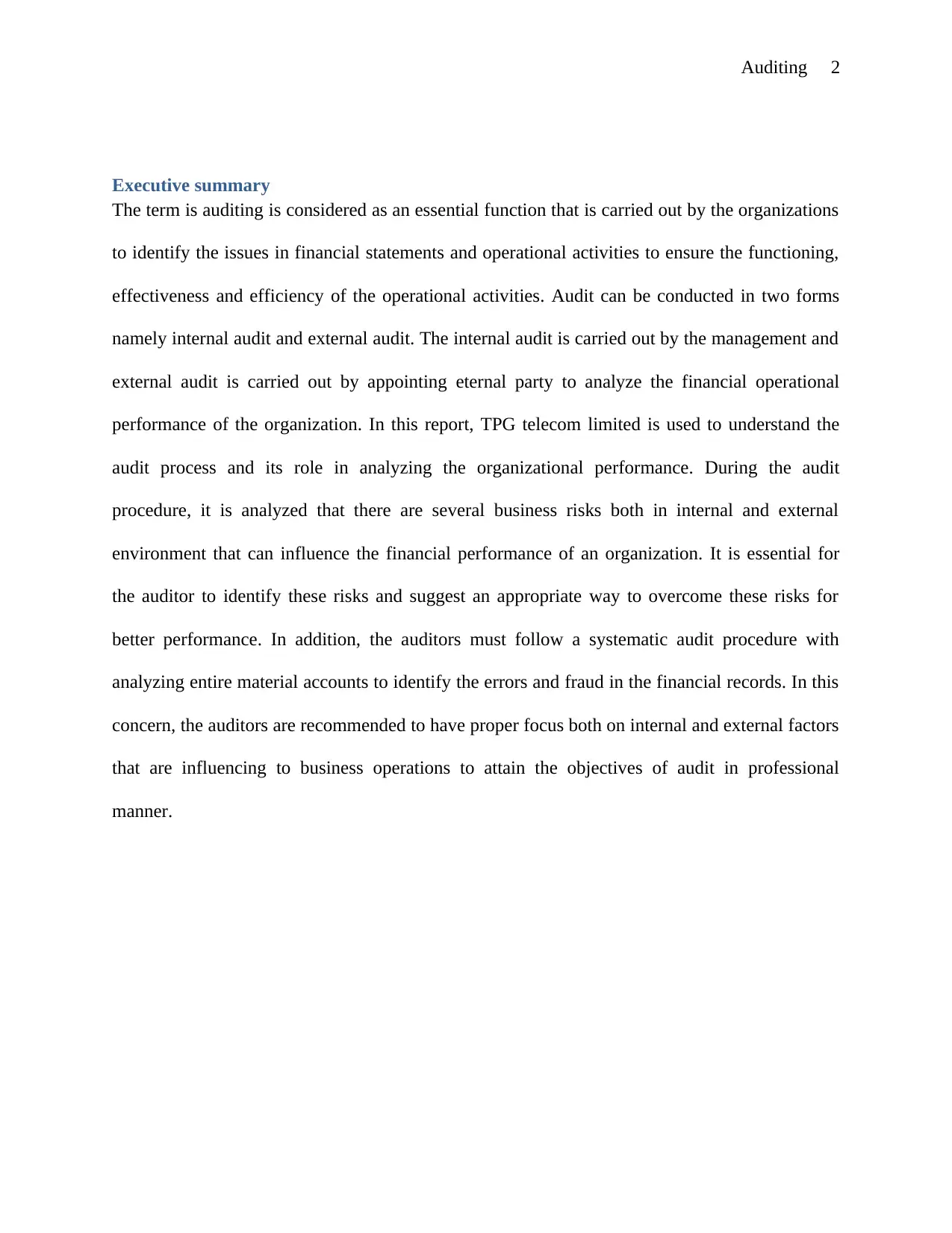
Auditing 2
Executive summary
The term is auditing is considered as an essential function that is carried out by the organizations
to identify the issues in financial statements and operational activities to ensure the functioning,
effectiveness and efficiency of the operational activities. Audit can be conducted in two forms
namely internal audit and external audit. The internal audit is carried out by the management and
external audit is carried out by appointing eternal party to analyze the financial operational
performance of the organization. In this report, TPG telecom limited is used to understand the
audit process and its role in analyzing the organizational performance. During the audit
procedure, it is analyzed that there are several business risks both in internal and external
environment that can influence the financial performance of an organization. It is essential for
the auditor to identify these risks and suggest an appropriate way to overcome these risks for
better performance. In addition, the auditors must follow a systematic audit procedure with
analyzing entire material accounts to identify the errors and fraud in the financial records. In this
concern, the auditors are recommended to have proper focus both on internal and external factors
that are influencing to business operations to attain the objectives of audit in professional
manner.
Executive summary
The term is auditing is considered as an essential function that is carried out by the organizations
to identify the issues in financial statements and operational activities to ensure the functioning,
effectiveness and efficiency of the operational activities. Audit can be conducted in two forms
namely internal audit and external audit. The internal audit is carried out by the management and
external audit is carried out by appointing eternal party to analyze the financial operational
performance of the organization. In this report, TPG telecom limited is used to understand the
audit process and its role in analyzing the organizational performance. During the audit
procedure, it is analyzed that there are several business risks both in internal and external
environment that can influence the financial performance of an organization. It is essential for
the auditor to identify these risks and suggest an appropriate way to overcome these risks for
better performance. In addition, the auditors must follow a systematic audit procedure with
analyzing entire material accounts to identify the errors and fraud in the financial records. In this
concern, the auditors are recommended to have proper focus both on internal and external factors
that are influencing to business operations to attain the objectives of audit in professional
manner.
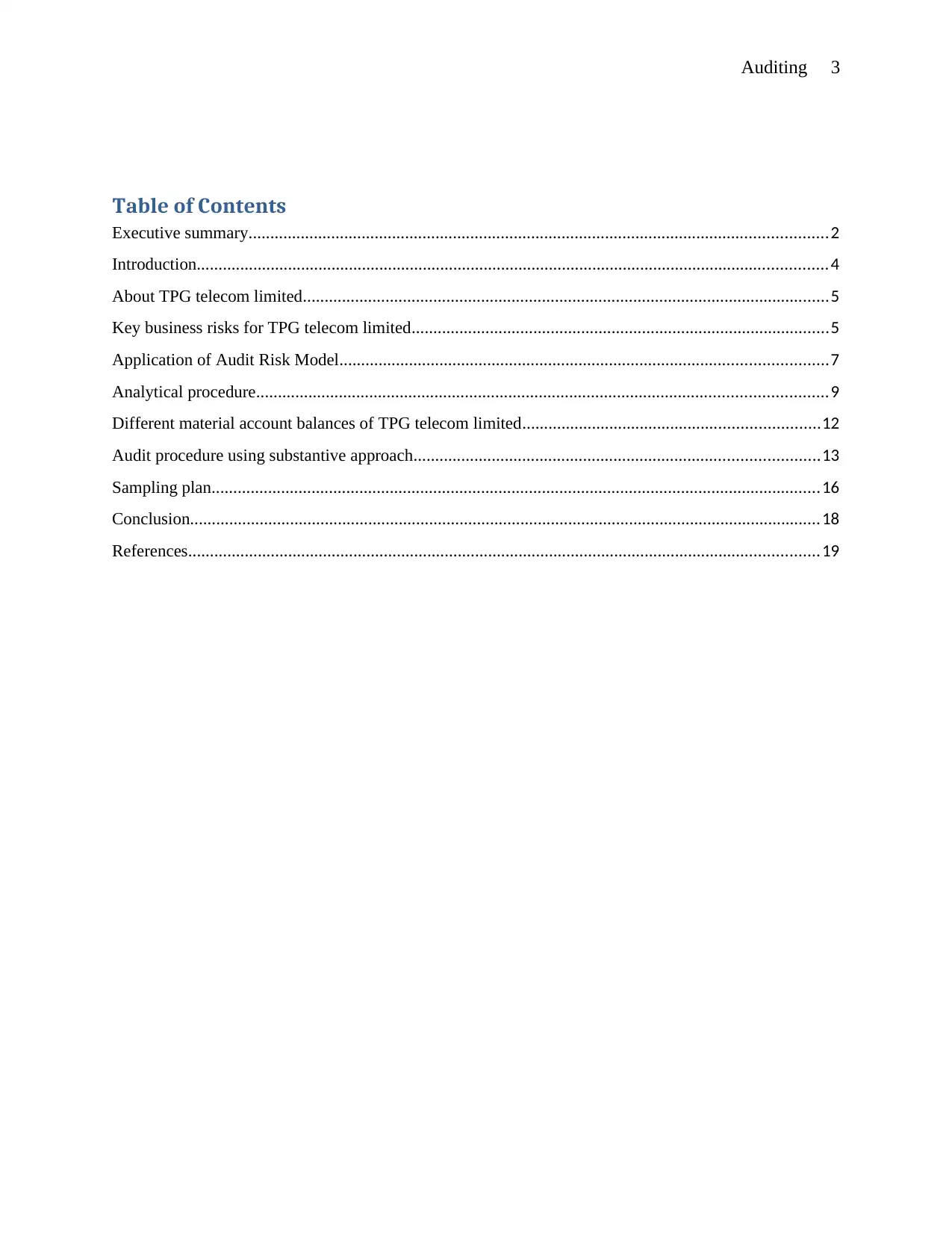
Auditing 3
Table of Contents
Executive summary.....................................................................................................................................2
Introduction.................................................................................................................................................4
About TPG telecom limited.........................................................................................................................5
Key business risks for TPG telecom limited................................................................................................5
Application of Audit Risk Model................................................................................................................7
Analytical procedure...................................................................................................................................9
Different material account balances of TPG telecom limited....................................................................12
Audit procedure using substantive approach.............................................................................................13
Sampling plan............................................................................................................................................16
Conclusion.................................................................................................................................................18
References.................................................................................................................................................19
Table of Contents
Executive summary.....................................................................................................................................2
Introduction.................................................................................................................................................4
About TPG telecom limited.........................................................................................................................5
Key business risks for TPG telecom limited................................................................................................5
Application of Audit Risk Model................................................................................................................7
Analytical procedure...................................................................................................................................9
Different material account balances of TPG telecom limited....................................................................12
Audit procedure using substantive approach.............................................................................................13
Sampling plan............................................................................................................................................16
Conclusion.................................................................................................................................................18
References.................................................................................................................................................19
⊘ This is a preview!⊘
Do you want full access?
Subscribe today to unlock all pages.

Trusted by 1+ million students worldwide
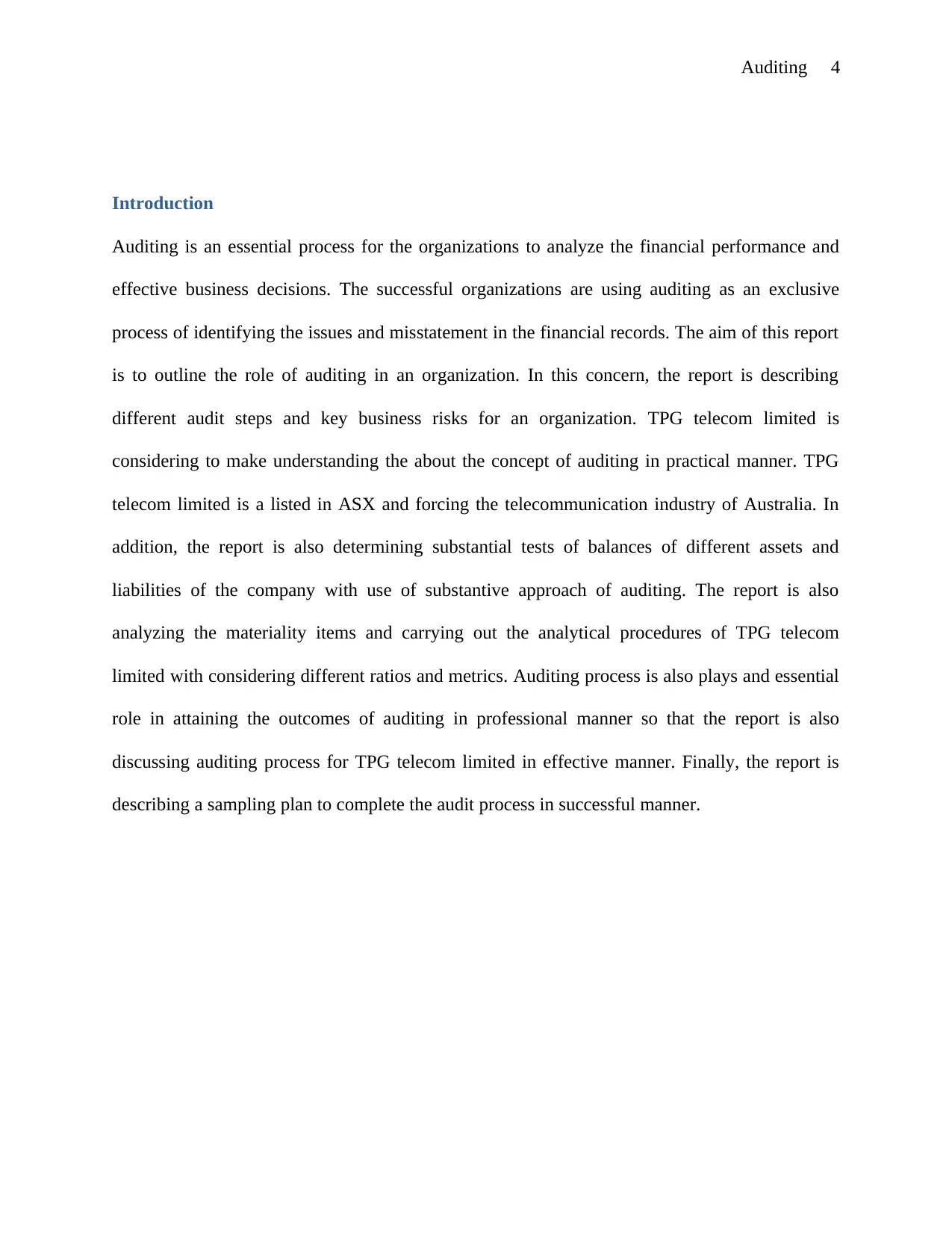
Auditing 4
Introduction
Auditing is an essential process for the organizations to analyze the financial performance and
effective business decisions. The successful organizations are using auditing as an exclusive
process of identifying the issues and misstatement in the financial records. The aim of this report
is to outline the role of auditing in an organization. In this concern, the report is describing
different audit steps and key business risks for an organization. TPG telecom limited is
considering to make understanding the about the concept of auditing in practical manner. TPG
telecom limited is a listed in ASX and forcing the telecommunication industry of Australia. In
addition, the report is also determining substantial tests of balances of different assets and
liabilities of the company with use of substantive approach of auditing. The report is also
analyzing the materiality items and carrying out the analytical procedures of TPG telecom
limited with considering different ratios and metrics. Auditing process is also plays and essential
role in attaining the outcomes of auditing in professional manner so that the report is also
discussing auditing process for TPG telecom limited in effective manner. Finally, the report is
describing a sampling plan to complete the audit process in successful manner.
Introduction
Auditing is an essential process for the organizations to analyze the financial performance and
effective business decisions. The successful organizations are using auditing as an exclusive
process of identifying the issues and misstatement in the financial records. The aim of this report
is to outline the role of auditing in an organization. In this concern, the report is describing
different audit steps and key business risks for an organization. TPG telecom limited is
considering to make understanding the about the concept of auditing in practical manner. TPG
telecom limited is a listed in ASX and forcing the telecommunication industry of Australia. In
addition, the report is also determining substantial tests of balances of different assets and
liabilities of the company with use of substantive approach of auditing. The report is also
analyzing the materiality items and carrying out the analytical procedures of TPG telecom
limited with considering different ratios and metrics. Auditing process is also plays and essential
role in attaining the outcomes of auditing in professional manner so that the report is also
discussing auditing process for TPG telecom limited in effective manner. Finally, the report is
describing a sampling plan to complete the audit process in successful manner.
Paraphrase This Document
Need a fresh take? Get an instant paraphrase of this document with our AI Paraphraser
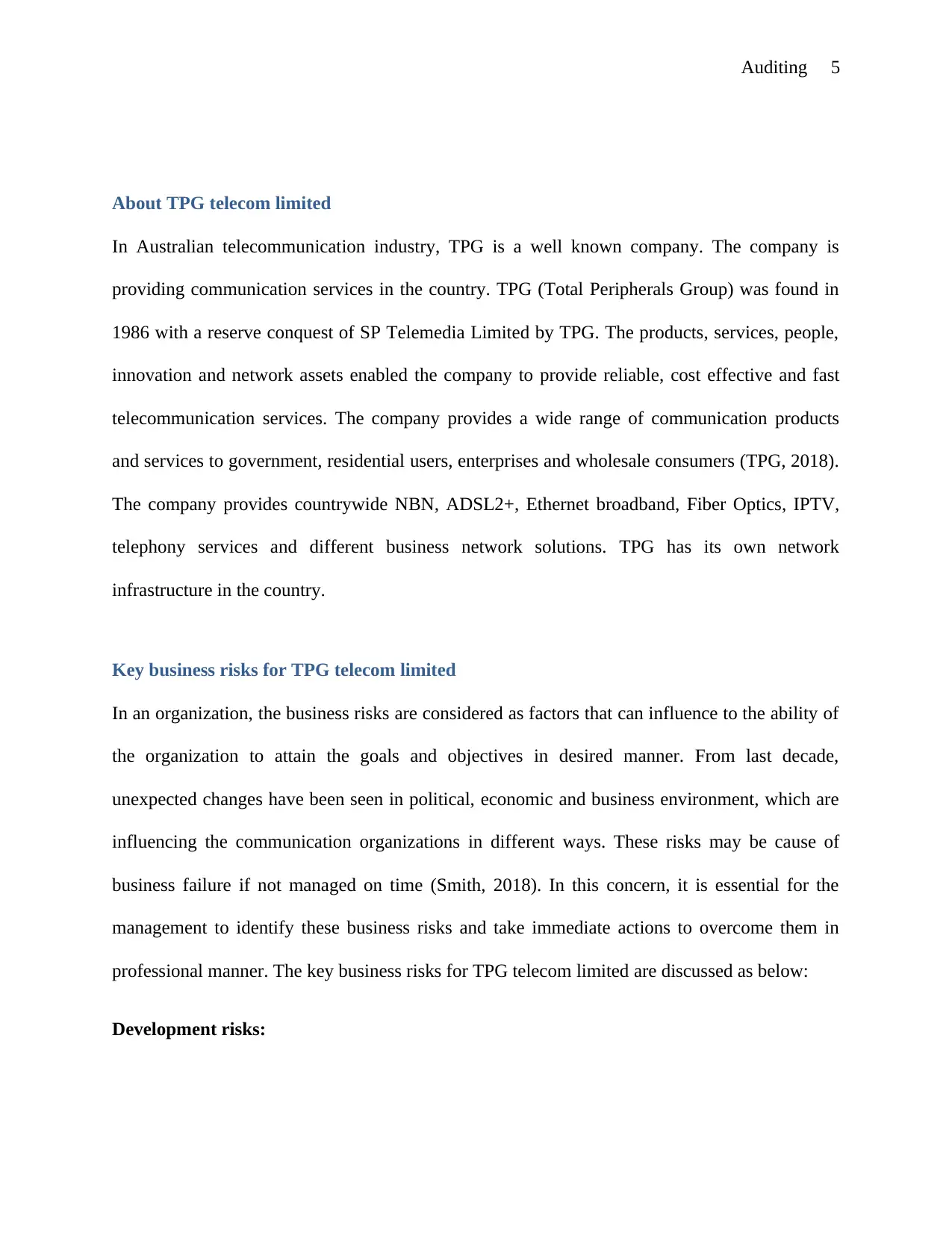
Auditing 5
About TPG telecom limited
In Australian telecommunication industry, TPG is a well known company. The company is
providing communication services in the country. TPG (Total Peripherals Group) was found in
1986 with a reserve conquest of SP Telemedia Limited by TPG. The products, services, people,
innovation and network assets enabled the company to provide reliable, cost effective and fast
telecommunication services. The company provides a wide range of communication products
and services to government, residential users, enterprises and wholesale consumers (TPG, 2018).
The company provides countrywide NBN, ADSL2+, Ethernet broadband, Fiber Optics, IPTV,
telephony services and different business network solutions. TPG has its own network
infrastructure in the country.
Key business risks for TPG telecom limited
In an organization, the business risks are considered as factors that can influence to the ability of
the organization to attain the goals and objectives in desired manner. From last decade,
unexpected changes have been seen in political, economic and business environment, which are
influencing the communication organizations in different ways. These risks may be cause of
business failure if not managed on time (Smith, 2018). In this concern, it is essential for the
management to identify these business risks and take immediate actions to overcome them in
professional manner. The key business risks for TPG telecom limited are discussed as below:
Development risks:
About TPG telecom limited
In Australian telecommunication industry, TPG is a well known company. The company is
providing communication services in the country. TPG (Total Peripherals Group) was found in
1986 with a reserve conquest of SP Telemedia Limited by TPG. The products, services, people,
innovation and network assets enabled the company to provide reliable, cost effective and fast
telecommunication services. The company provides a wide range of communication products
and services to government, residential users, enterprises and wholesale consumers (TPG, 2018).
The company provides countrywide NBN, ADSL2+, Ethernet broadband, Fiber Optics, IPTV,
telephony services and different business network solutions. TPG has its own network
infrastructure in the country.
Key business risks for TPG telecom limited
In an organization, the business risks are considered as factors that can influence to the ability of
the organization to attain the goals and objectives in desired manner. From last decade,
unexpected changes have been seen in political, economic and business environment, which are
influencing the communication organizations in different ways. These risks may be cause of
business failure if not managed on time (Smith, 2018). In this concern, it is essential for the
management to identify these business risks and take immediate actions to overcome them in
professional manner. The key business risks for TPG telecom limited are discussed as below:
Development risks:
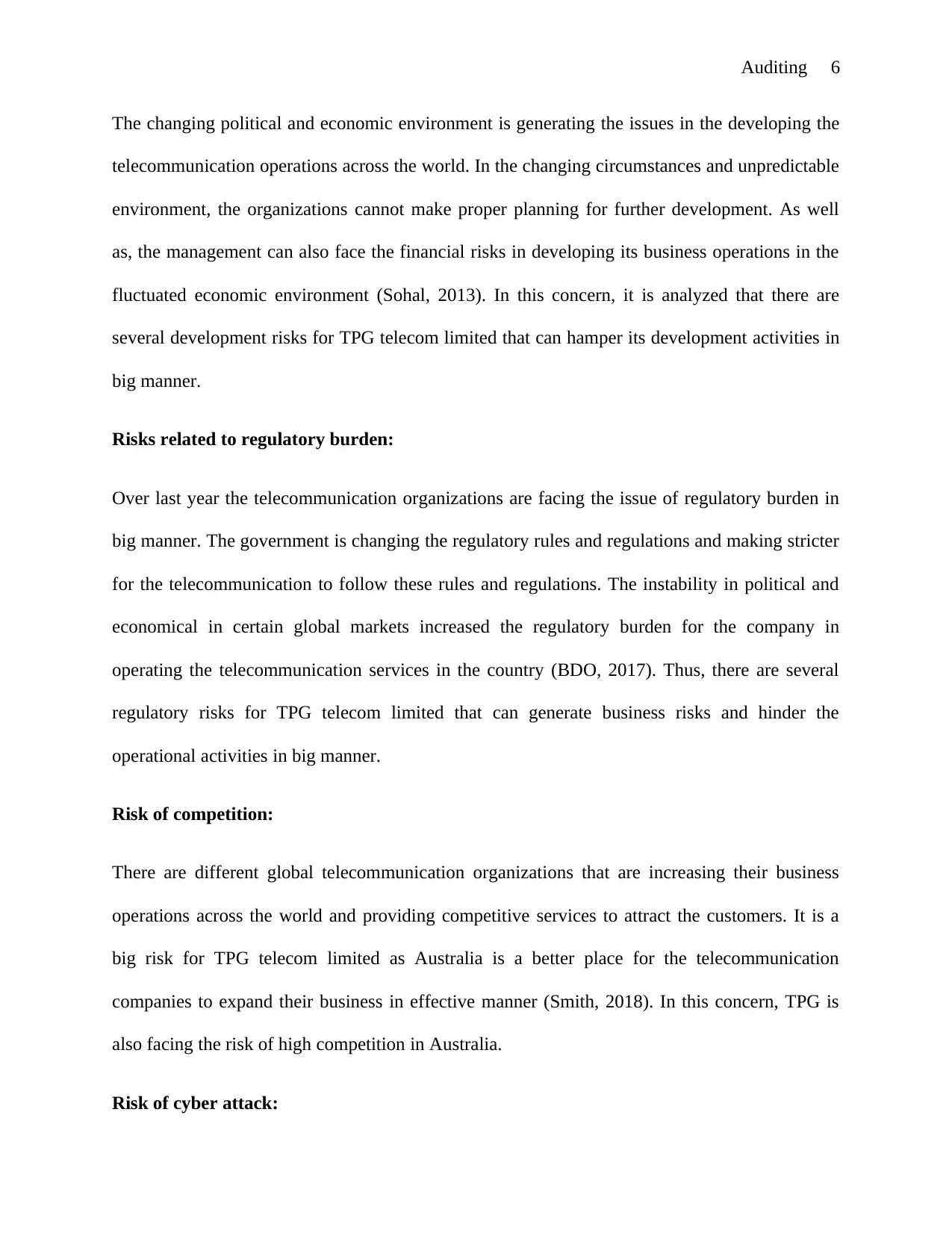
Auditing 6
The changing political and economic environment is generating the issues in the developing the
telecommunication operations across the world. In the changing circumstances and unpredictable
environment, the organizations cannot make proper planning for further development. As well
as, the management can also face the financial risks in developing its business operations in the
fluctuated economic environment (Sohal, 2013). In this concern, it is analyzed that there are
several development risks for TPG telecom limited that can hamper its development activities in
big manner.
Risks related to regulatory burden:
Over last year the telecommunication organizations are facing the issue of regulatory burden in
big manner. The government is changing the regulatory rules and regulations and making stricter
for the telecommunication to follow these rules and regulations. The instability in political and
economical in certain global markets increased the regulatory burden for the company in
operating the telecommunication services in the country (BDO, 2017). Thus, there are several
regulatory risks for TPG telecom limited that can generate business risks and hinder the
operational activities in big manner.
Risk of competition:
There are different global telecommunication organizations that are increasing their business
operations across the world and providing competitive services to attract the customers. It is a
big risk for TPG telecom limited as Australia is a better place for the telecommunication
companies to expand their business in effective manner (Smith, 2018). In this concern, TPG is
also facing the risk of high competition in Australia.
Risk of cyber attack:
The changing political and economic environment is generating the issues in the developing the
telecommunication operations across the world. In the changing circumstances and unpredictable
environment, the organizations cannot make proper planning for further development. As well
as, the management can also face the financial risks in developing its business operations in the
fluctuated economic environment (Sohal, 2013). In this concern, it is analyzed that there are
several development risks for TPG telecom limited that can hamper its development activities in
big manner.
Risks related to regulatory burden:
Over last year the telecommunication organizations are facing the issue of regulatory burden in
big manner. The government is changing the regulatory rules and regulations and making stricter
for the telecommunication to follow these rules and regulations. The instability in political and
economical in certain global markets increased the regulatory burden for the company in
operating the telecommunication services in the country (BDO, 2017). Thus, there are several
regulatory risks for TPG telecom limited that can generate business risks and hinder the
operational activities in big manner.
Risk of competition:
There are different global telecommunication organizations that are increasing their business
operations across the world and providing competitive services to attract the customers. It is a
big risk for TPG telecom limited as Australia is a better place for the telecommunication
companies to expand their business in effective manner (Smith, 2018). In this concern, TPG is
also facing the risk of high competition in Australia.
Risk of cyber attack:
⊘ This is a preview!⊘
Do you want full access?
Subscribe today to unlock all pages.

Trusted by 1+ million students worldwide
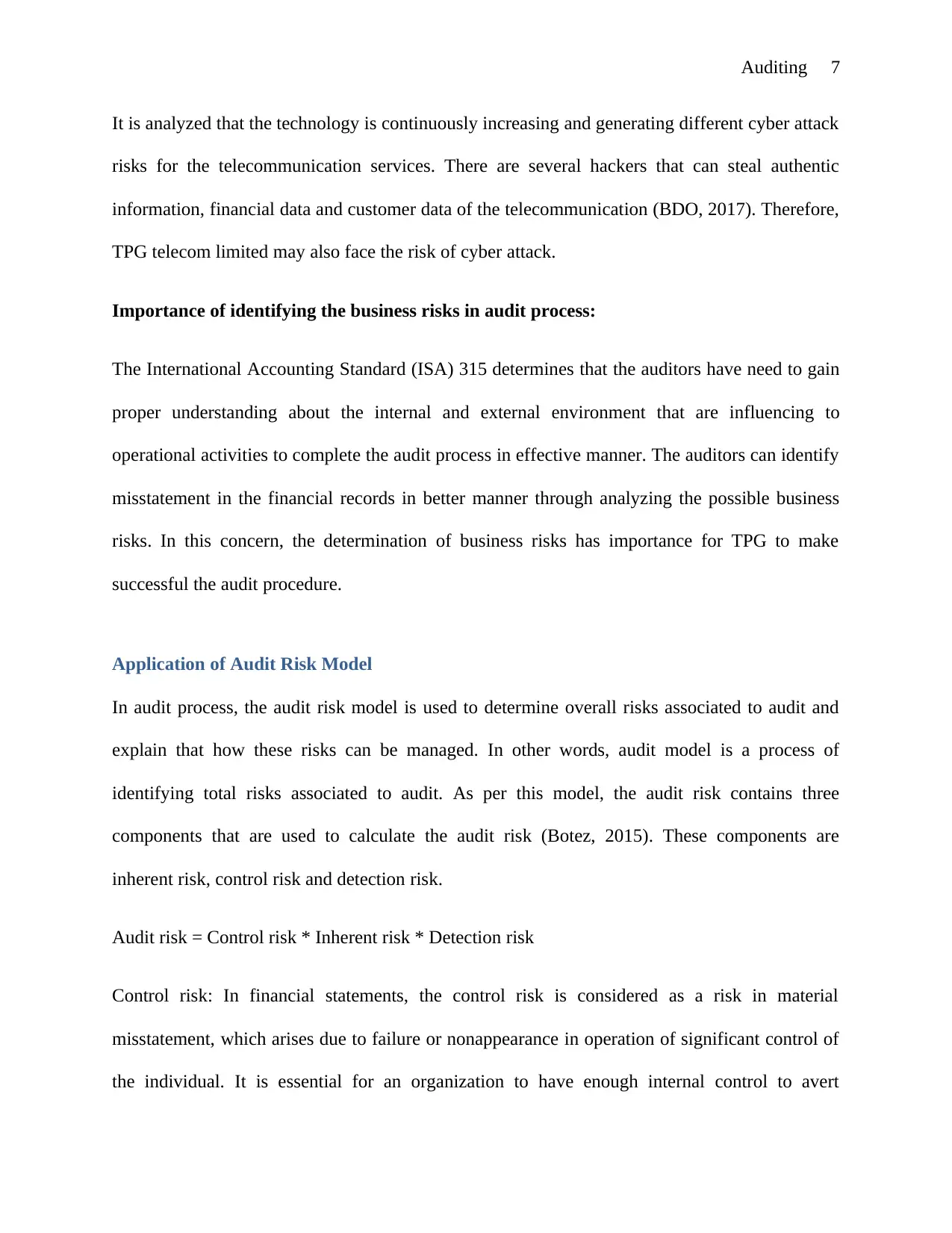
Auditing 7
It is analyzed that the technology is continuously increasing and generating different cyber attack
risks for the telecommunication services. There are several hackers that can steal authentic
information, financial data and customer data of the telecommunication (BDO, 2017). Therefore,
TPG telecom limited may also face the risk of cyber attack.
Importance of identifying the business risks in audit process:
The International Accounting Standard (ISA) 315 determines that the auditors have need to gain
proper understanding about the internal and external environment that are influencing to
operational activities to complete the audit process in effective manner. The auditors can identify
misstatement in the financial records in better manner through analyzing the possible business
risks. In this concern, the determination of business risks has importance for TPG to make
successful the audit procedure.
Application of Audit Risk Model
In audit process, the audit risk model is used to determine overall risks associated to audit and
explain that how these risks can be managed. In other words, audit model is a process of
identifying total risks associated to audit. As per this model, the audit risk contains three
components that are used to calculate the audit risk (Botez, 2015). These components are
inherent risk, control risk and detection risk.
Audit risk = Control risk * Inherent risk * Detection risk
Control risk: In financial statements, the control risk is considered as a risk in material
misstatement, which arises due to failure or nonappearance in operation of significant control of
the individual. It is essential for an organization to have enough internal control to avert
It is analyzed that the technology is continuously increasing and generating different cyber attack
risks for the telecommunication services. There are several hackers that can steal authentic
information, financial data and customer data of the telecommunication (BDO, 2017). Therefore,
TPG telecom limited may also face the risk of cyber attack.
Importance of identifying the business risks in audit process:
The International Accounting Standard (ISA) 315 determines that the auditors have need to gain
proper understanding about the internal and external environment that are influencing to
operational activities to complete the audit process in effective manner. The auditors can identify
misstatement in the financial records in better manner through analyzing the possible business
risks. In this concern, the determination of business risks has importance for TPG to make
successful the audit procedure.
Application of Audit Risk Model
In audit process, the audit risk model is used to determine overall risks associated to audit and
explain that how these risks can be managed. In other words, audit model is a process of
identifying total risks associated to audit. As per this model, the audit risk contains three
components that are used to calculate the audit risk (Botez, 2015). These components are
inherent risk, control risk and detection risk.
Audit risk = Control risk * Inherent risk * Detection risk
Control risk: In financial statements, the control risk is considered as a risk in material
misstatement, which arises due to failure or nonappearance in operation of significant control of
the individual. It is essential for an organization to have enough internal control to avert
Paraphrase This Document
Need a fresh take? Get an instant paraphrase of this document with our AI Paraphraser
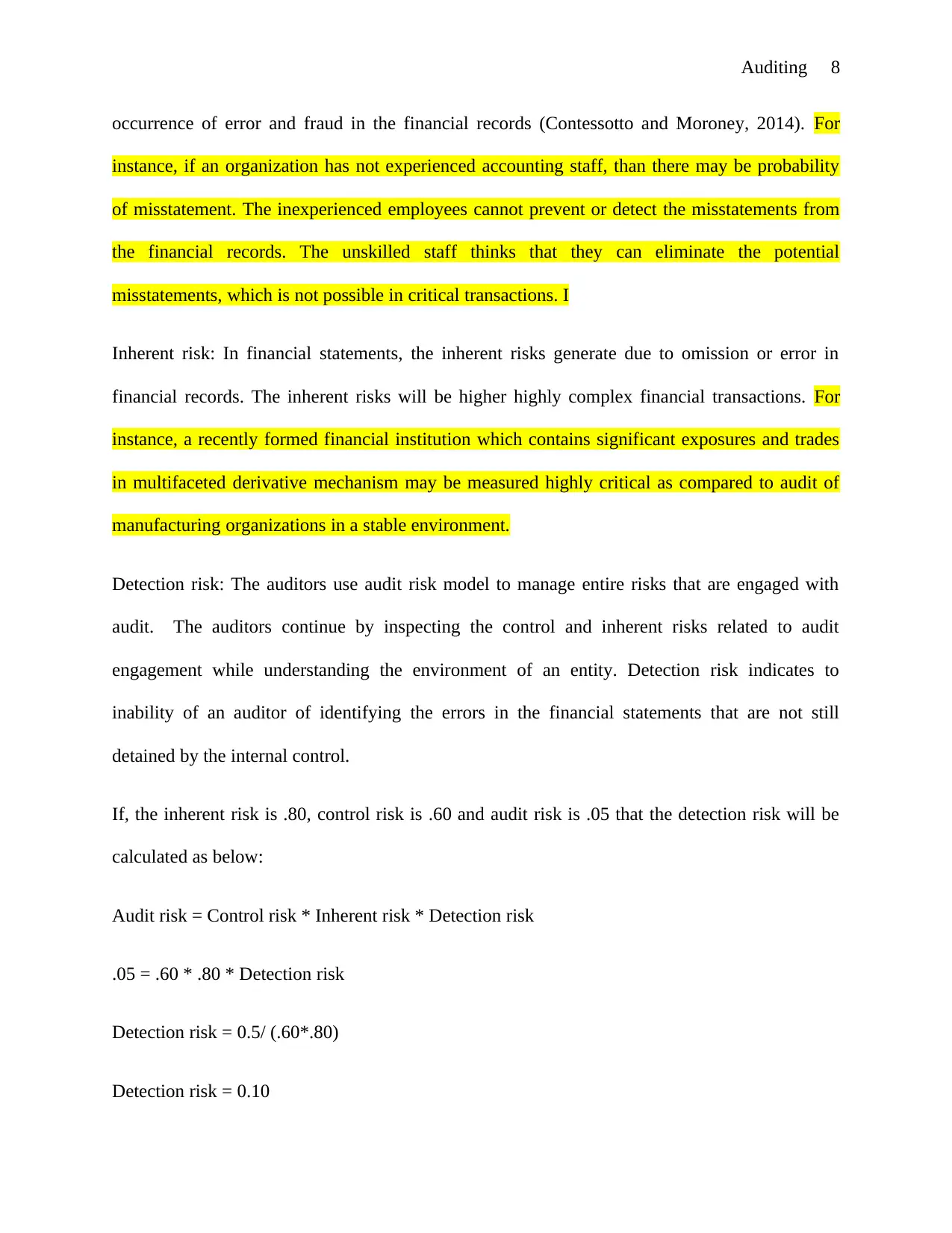
Auditing 8
occurrence of error and fraud in the financial records (Contessotto and Moroney, 2014). For
instance, if an organization has not experienced accounting staff, than there may be probability
of misstatement. The inexperienced employees cannot prevent or detect the misstatements from
the financial records. The unskilled staff thinks that they can eliminate the potential
misstatements, which is not possible in critical transactions. I
Inherent risk: In financial statements, the inherent risks generate due to omission or error in
financial records. The inherent risks will be higher highly complex financial transactions. For
instance, a recently formed financial institution which contains significant exposures and trades
in multifaceted derivative mechanism may be measured highly critical as compared to audit of
manufacturing organizations in a stable environment.
Detection risk: The auditors use audit risk model to manage entire risks that are engaged with
audit. The auditors continue by inspecting the control and inherent risks related to audit
engagement while understanding the environment of an entity. Detection risk indicates to
inability of an auditor of identifying the errors in the financial statements that are not still
detained by the internal control.
If, the inherent risk is .80, control risk is .60 and audit risk is .05 that the detection risk will be
calculated as below:
Audit risk = Control risk * Inherent risk * Detection risk
.05 = .60 * .80 * Detection risk
Detection risk = 0.5/ (.60*.80)
Detection risk = 0.10
occurrence of error and fraud in the financial records (Contessotto and Moroney, 2014). For
instance, if an organization has not experienced accounting staff, than there may be probability
of misstatement. The inexperienced employees cannot prevent or detect the misstatements from
the financial records. The unskilled staff thinks that they can eliminate the potential
misstatements, which is not possible in critical transactions. I
Inherent risk: In financial statements, the inherent risks generate due to omission or error in
financial records. The inherent risks will be higher highly complex financial transactions. For
instance, a recently formed financial institution which contains significant exposures and trades
in multifaceted derivative mechanism may be measured highly critical as compared to audit of
manufacturing organizations in a stable environment.
Detection risk: The auditors use audit risk model to manage entire risks that are engaged with
audit. The auditors continue by inspecting the control and inherent risks related to audit
engagement while understanding the environment of an entity. Detection risk indicates to
inability of an auditor of identifying the errors in the financial statements that are not still
detained by the internal control.
If, the inherent risk is .80, control risk is .60 and audit risk is .05 that the detection risk will be
calculated as below:
Audit risk = Control risk * Inherent risk * Detection risk
.05 = .60 * .80 * Detection risk
Detection risk = 0.5/ (.60*.80)
Detection risk = 0.10
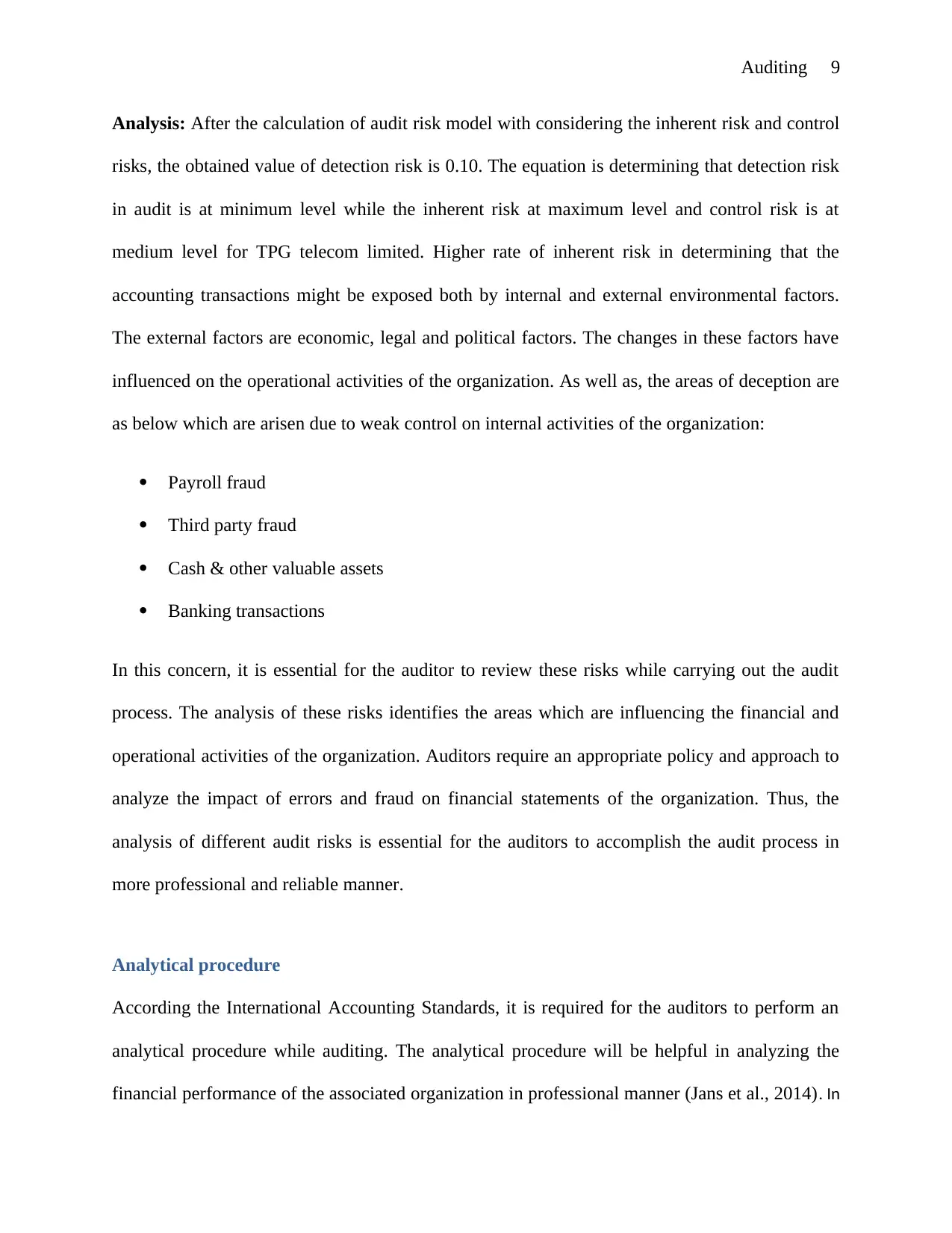
Auditing 9
Analysis: After the calculation of audit risk model with considering the inherent risk and control
risks, the obtained value of detection risk is 0.10. The equation is determining that detection risk
in audit is at minimum level while the inherent risk at maximum level and control risk is at
medium level for TPG telecom limited. Higher rate of inherent risk in determining that the
accounting transactions might be exposed both by internal and external environmental factors.
The external factors are economic, legal and political factors. The changes in these factors have
influenced on the operational activities of the organization. As well as, the areas of deception are
as below which are arisen due to weak control on internal activities of the organization:
Payroll fraud
Third party fraud
Cash & other valuable assets
Banking transactions
In this concern, it is essential for the auditor to review these risks while carrying out the audit
process. The analysis of these risks identifies the areas which are influencing the financial and
operational activities of the organization. Auditors require an appropriate policy and approach to
analyze the impact of errors and fraud on financial statements of the organization. Thus, the
analysis of different audit risks is essential for the auditors to accomplish the audit process in
more professional and reliable manner.
Analytical procedure
According the International Accounting Standards, it is required for the auditors to perform an
analytical procedure while auditing. The analytical procedure will be helpful in analyzing the
financial performance of the associated organization in professional manner (Jans et al., 2014). In
Analysis: After the calculation of audit risk model with considering the inherent risk and control
risks, the obtained value of detection risk is 0.10. The equation is determining that detection risk
in audit is at minimum level while the inherent risk at maximum level and control risk is at
medium level for TPG telecom limited. Higher rate of inherent risk in determining that the
accounting transactions might be exposed both by internal and external environmental factors.
The external factors are economic, legal and political factors. The changes in these factors have
influenced on the operational activities of the organization. As well as, the areas of deception are
as below which are arisen due to weak control on internal activities of the organization:
Payroll fraud
Third party fraud
Cash & other valuable assets
Banking transactions
In this concern, it is essential for the auditor to review these risks while carrying out the audit
process. The analysis of these risks identifies the areas which are influencing the financial and
operational activities of the organization. Auditors require an appropriate policy and approach to
analyze the impact of errors and fraud on financial statements of the organization. Thus, the
analysis of different audit risks is essential for the auditors to accomplish the audit process in
more professional and reliable manner.
Analytical procedure
According the International Accounting Standards, it is required for the auditors to perform an
analytical procedure while auditing. The analytical procedure will be helpful in analyzing the
financial performance of the associated organization in professional manner (Jans et al., 2014). In
⊘ This is a preview!⊘
Do you want full access?
Subscribe today to unlock all pages.

Trusted by 1+ million students worldwide
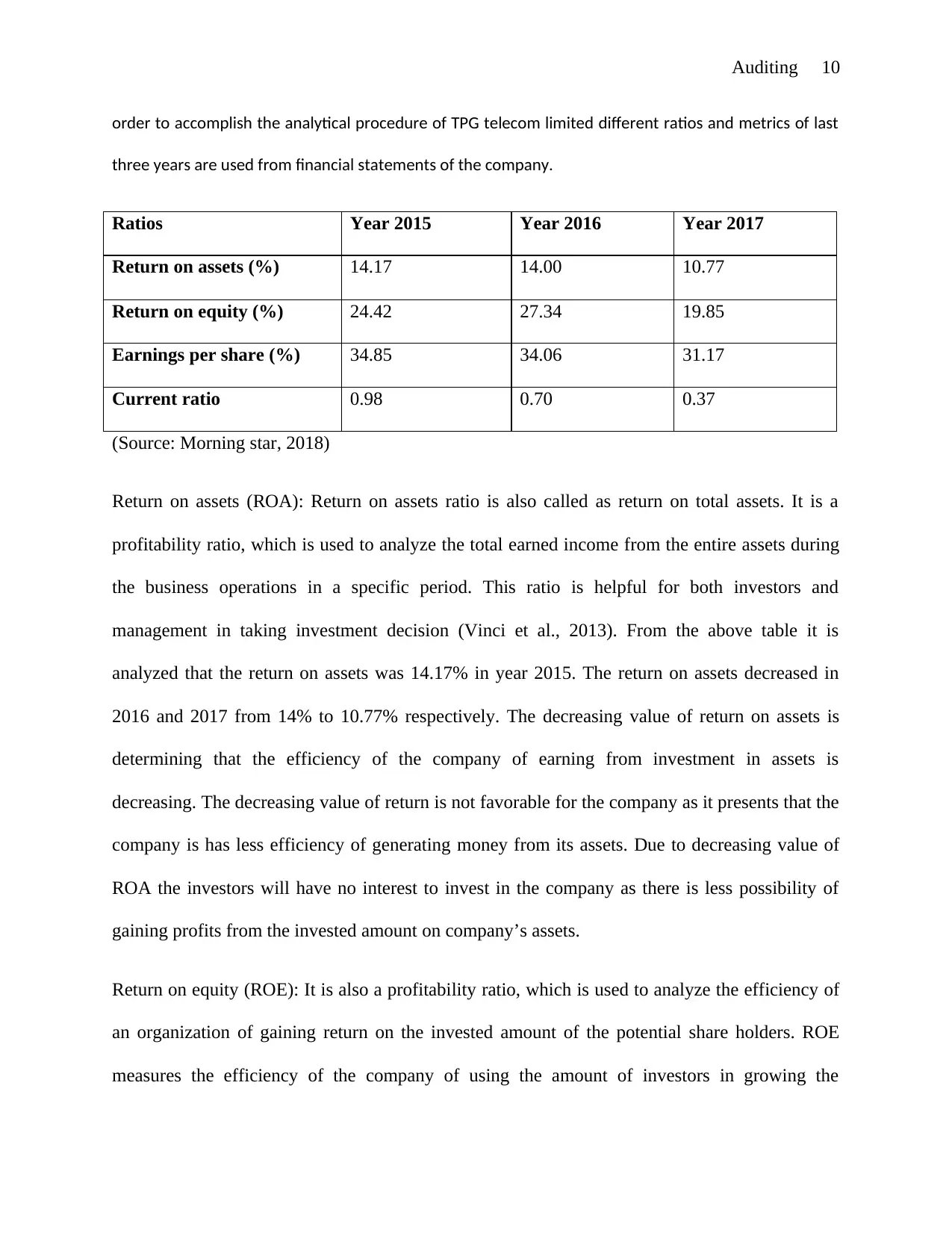
Auditing 10
order to accomplish the analytical procedure of TPG telecom limited different ratios and metrics of last
three years are used from financial statements of the company.
Ratios Year 2015 Year 2016 Year 2017
Return on assets (%) 14.17 14.00 10.77
Return on equity (%) 24.42 27.34 19.85
Earnings per share (%) 34.85 34.06 31.17
Current ratio 0.98 0.70 0.37
(Source: Morning star, 2018)
Return on assets (ROA): Return on assets ratio is also called as return on total assets. It is a
profitability ratio, which is used to analyze the total earned income from the entire assets during
the business operations in a specific period. This ratio is helpful for both investors and
management in taking investment decision (Vinci et al., 2013). From the above table it is
analyzed that the return on assets was 14.17% in year 2015. The return on assets decreased in
2016 and 2017 from 14% to 10.77% respectively. The decreasing value of return on assets is
determining that the efficiency of the company of earning from investment in assets is
decreasing. The decreasing value of return is not favorable for the company as it presents that the
company is has less efficiency of generating money from its assets. Due to decreasing value of
ROA the investors will have no interest to invest in the company as there is less possibility of
gaining profits from the invested amount on company’s assets.
Return on equity (ROE): It is also a profitability ratio, which is used to analyze the efficiency of
an organization of gaining return on the invested amount of the potential share holders. ROE
measures the efficiency of the company of using the amount of investors in growing the
order to accomplish the analytical procedure of TPG telecom limited different ratios and metrics of last
three years are used from financial statements of the company.
Ratios Year 2015 Year 2016 Year 2017
Return on assets (%) 14.17 14.00 10.77
Return on equity (%) 24.42 27.34 19.85
Earnings per share (%) 34.85 34.06 31.17
Current ratio 0.98 0.70 0.37
(Source: Morning star, 2018)
Return on assets (ROA): Return on assets ratio is also called as return on total assets. It is a
profitability ratio, which is used to analyze the total earned income from the entire assets during
the business operations in a specific period. This ratio is helpful for both investors and
management in taking investment decision (Vinci et al., 2013). From the above table it is
analyzed that the return on assets was 14.17% in year 2015. The return on assets decreased in
2016 and 2017 from 14% to 10.77% respectively. The decreasing value of return on assets is
determining that the efficiency of the company of earning from investment in assets is
decreasing. The decreasing value of return is not favorable for the company as it presents that the
company is has less efficiency of generating money from its assets. Due to decreasing value of
ROA the investors will have no interest to invest in the company as there is less possibility of
gaining profits from the invested amount on company’s assets.
Return on equity (ROE): It is also a profitability ratio, which is used to analyze the efficiency of
an organization of gaining return on the invested amount of the potential share holders. ROE
measures the efficiency of the company of using the amount of investors in growing the
Paraphrase This Document
Need a fresh take? Get an instant paraphrase of this document with our AI Paraphraser
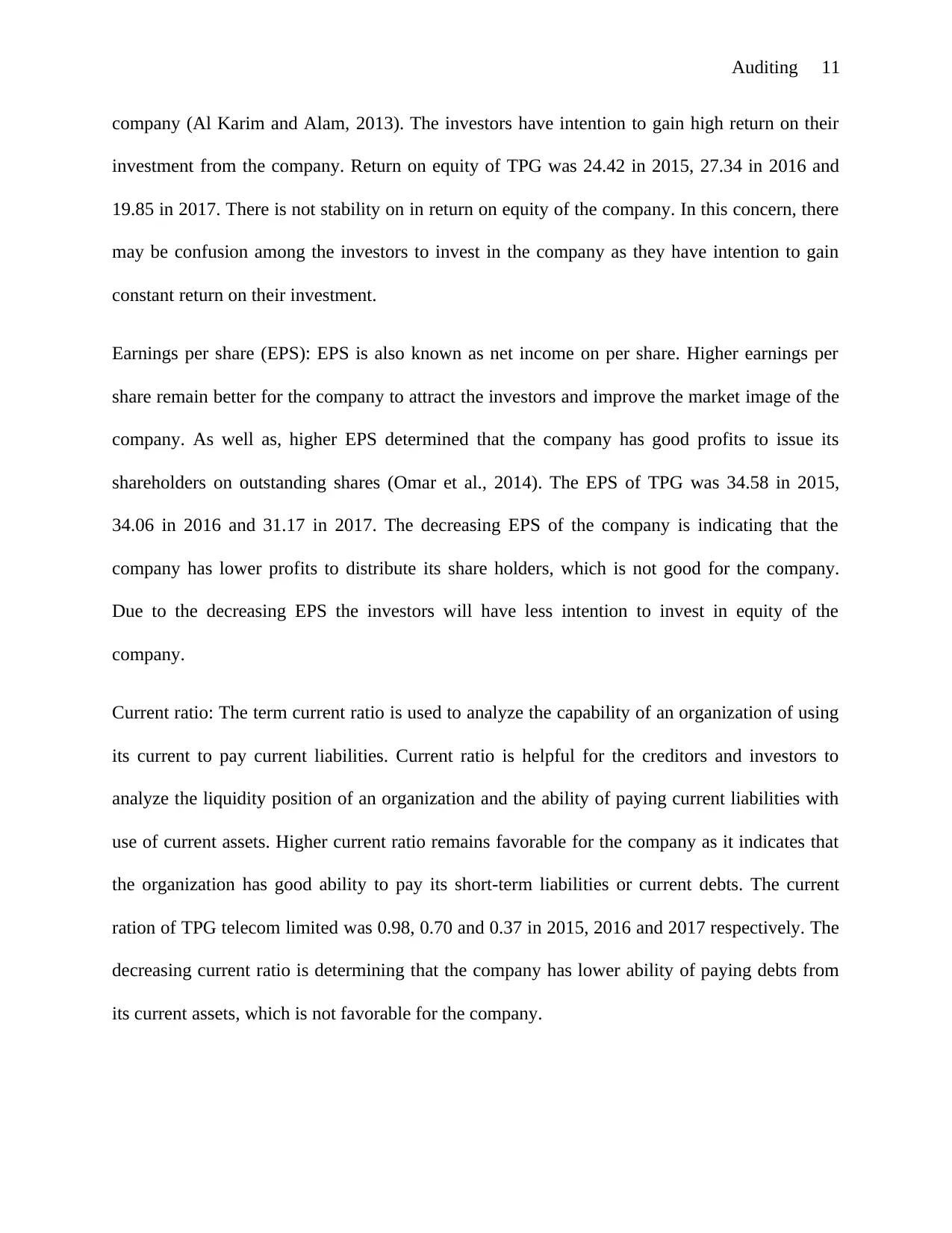
Auditing 11
company (Al Karim and Alam, 2013). The investors have intention to gain high return on their
investment from the company. Return on equity of TPG was 24.42 in 2015, 27.34 in 2016 and
19.85 in 2017. There is not stability on in return on equity of the company. In this concern, there
may be confusion among the investors to invest in the company as they have intention to gain
constant return on their investment.
Earnings per share (EPS): EPS is also known as net income on per share. Higher earnings per
share remain better for the company to attract the investors and improve the market image of the
company. As well as, higher EPS determined that the company has good profits to issue its
shareholders on outstanding shares (Omar et al., 2014). The EPS of TPG was 34.58 in 2015,
34.06 in 2016 and 31.17 in 2017. The decreasing EPS of the company is indicating that the
company has lower profits to distribute its share holders, which is not good for the company.
Due to the decreasing EPS the investors will have less intention to invest in equity of the
company.
Current ratio: The term current ratio is used to analyze the capability of an organization of using
its current to pay current liabilities. Current ratio is helpful for the creditors and investors to
analyze the liquidity position of an organization and the ability of paying current liabilities with
use of current assets. Higher current ratio remains favorable for the company as it indicates that
the organization has good ability to pay its short-term liabilities or current debts. The current
ration of TPG telecom limited was 0.98, 0.70 and 0.37 in 2015, 2016 and 2017 respectively. The
decreasing current ratio is determining that the company has lower ability of paying debts from
its current assets, which is not favorable for the company.
company (Al Karim and Alam, 2013). The investors have intention to gain high return on their
investment from the company. Return on equity of TPG was 24.42 in 2015, 27.34 in 2016 and
19.85 in 2017. There is not stability on in return on equity of the company. In this concern, there
may be confusion among the investors to invest in the company as they have intention to gain
constant return on their investment.
Earnings per share (EPS): EPS is also known as net income on per share. Higher earnings per
share remain better for the company to attract the investors and improve the market image of the
company. As well as, higher EPS determined that the company has good profits to issue its
shareholders on outstanding shares (Omar et al., 2014). The EPS of TPG was 34.58 in 2015,
34.06 in 2016 and 31.17 in 2017. The decreasing EPS of the company is indicating that the
company has lower profits to distribute its share holders, which is not good for the company.
Due to the decreasing EPS the investors will have less intention to invest in equity of the
company.
Current ratio: The term current ratio is used to analyze the capability of an organization of using
its current to pay current liabilities. Current ratio is helpful for the creditors and investors to
analyze the liquidity position of an organization and the ability of paying current liabilities with
use of current assets. Higher current ratio remains favorable for the company as it indicates that
the organization has good ability to pay its short-term liabilities or current debts. The current
ration of TPG telecom limited was 0.98, 0.70 and 0.37 in 2015, 2016 and 2017 respectively. The
decreasing current ratio is determining that the company has lower ability of paying debts from
its current assets, which is not favorable for the company.
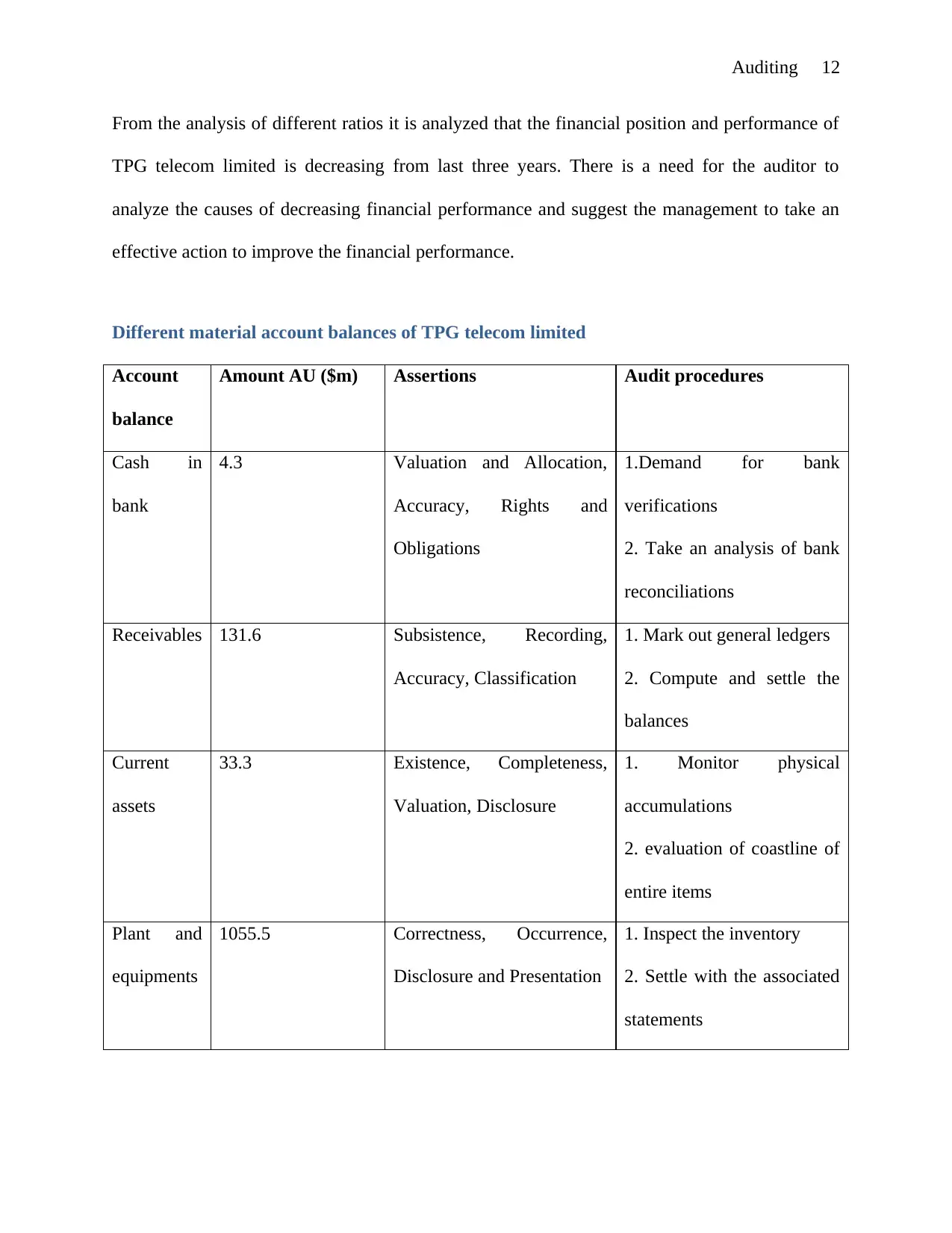
Auditing 12
From the analysis of different ratios it is analyzed that the financial position and performance of
TPG telecom limited is decreasing from last three years. There is a need for the auditor to
analyze the causes of decreasing financial performance and suggest the management to take an
effective action to improve the financial performance.
Different material account balances of TPG telecom limited
Account
balance
Amount AU ($m) Assertions Audit procedures
Cash in
bank
4.3 Valuation and Allocation,
Accuracy, Rights and
Obligations
1.Demand for bank
verifications
2. Take an analysis of bank
reconciliations
Receivables 131.6 Subsistence, Recording,
Accuracy, Classification
1. Mark out general ledgers
2. Compute and settle the
balances
Current
assets
33.3 Existence, Completeness,
Valuation, Disclosure
1. Monitor physical
accumulations
2. evaluation of coastline of
entire items
Plant and
equipments
1055.5 Correctness, Occurrence,
Disclosure and Presentation
1. Inspect the inventory
2. Settle with the associated
statements
From the analysis of different ratios it is analyzed that the financial position and performance of
TPG telecom limited is decreasing from last three years. There is a need for the auditor to
analyze the causes of decreasing financial performance and suggest the management to take an
effective action to improve the financial performance.
Different material account balances of TPG telecom limited
Account
balance
Amount AU ($m) Assertions Audit procedures
Cash in
bank
4.3 Valuation and Allocation,
Accuracy, Rights and
Obligations
1.Demand for bank
verifications
2. Take an analysis of bank
reconciliations
Receivables 131.6 Subsistence, Recording,
Accuracy, Classification
1. Mark out general ledgers
2. Compute and settle the
balances
Current
assets
33.3 Existence, Completeness,
Valuation, Disclosure
1. Monitor physical
accumulations
2. evaluation of coastline of
entire items
Plant and
equipments
1055.5 Correctness, Occurrence,
Disclosure and Presentation
1. Inspect the inventory
2. Settle with the associated
statements
⊘ This is a preview!⊘
Do you want full access?
Subscribe today to unlock all pages.

Trusted by 1+ million students worldwide
1 out of 20
Related Documents
Your All-in-One AI-Powered Toolkit for Academic Success.
+13062052269
info@desklib.com
Available 24*7 on WhatsApp / Email
![[object Object]](/_next/static/media/star-bottom.7253800d.svg)
Unlock your academic potential
Copyright © 2020–2025 A2Z Services. All Rights Reserved. Developed and managed by ZUCOL.




